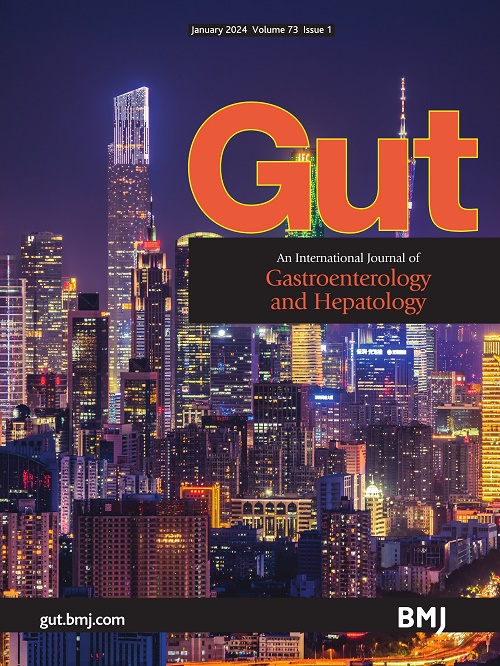Targeting Treg-fibroblast interaction to enhance immunotherapy in steatotic liver disease-related hepatocellular carcinoma.
IF 25.8
1区 医学
Q1 GASTROENTEROLOGY & HEPATOLOGY
引用次数: 0
Abstract
BACKGROUND Steatotic liver disease-related hepatocellular carcinoma (SLD-HCC), a rising global challenge, is characterised by unique tumour microenvironment (TME) adaptations. OBJECTIVE This study investigates the immune microenvironment and interactions driving immunosuppression and potential resistance to immunotherapy in SLD-HCC. DESIGN We employed single-cell transcriptomics, cytometry by time-of-flight (CyTOF) and two independent spatial transcriptomics platforms to study the TME of 22 SLD-HCC and 31 non-SLD-HCC cases. Findings were further validated using multiplex immunohistochemistry in an independent cohort of 103 patients, an HCC model and an immunotherapy-treated patient cohort to evaluate clinical relevance. RESULTS Our findings revealed significant alterations in immune and lipid metabolism pathways, particularly in regulatory T cells (Tregs) and cancer-associated fibroblasts (CAFs), suggesting distinct cellular adaptations to a high-fat TME and general immunosuppression. CyTOF revealed a cold, immunosuppressive TME with reduced CD8+ T cells and increased Tregs. Spatial transcriptomics further highlighted distinct Treg-CAF clusters localised at tumour margins, suggesting a spatially organised immunosuppressive niche. Mechanistically, tumour necrosis factor superfamily member 14 (TNFSF14)-tumour necrosis factor receptor superfamily member 14 (TNFRSF14)-mediated Treg-CAF interaction was identified as a critical driver of immunotherapy resistance in SLD-HCC. Blocking TNFRSF14 in an HCC model fed with a high-fat diet resulted in reduced Tregs, increased active CD8+ and memory CD4+ T cells, and a synergistic effect with anti-programmed cell death protein 1 therapy to enhance antitumour immunity and overcome immunotherapy resistance in SLD-HCC. CONCLUSION This study uncovers critical immune and metabolic adaptations in SLD-HCC, identifying TNFSF14-TNFRSF14 signalling as a key driver of immunotherapy resistance. Targeting this signalling axis enhances antitumour immunity and improves immunotherapy efficacy, offering a promising therapeutic strategy for SLD-HCC.靶向treg -成纤维细胞相互作用增强脂肪变性肝病相关肝癌的免疫治疗
背景:脂肪变性肝病相关肝细胞癌(SLD-HCC)是一个日益上升的全球性挑战,其特征是独特的肿瘤微环境(TME)适应性。目的探讨SLD-HCC患者的免疫微环境及其相互作用对免疫抑制和免疫治疗潜在耐药性的影响。我们采用单细胞转录组学、细胞飞行时间(CyTOF)和两个独立的空间转录组学平台对22例SLD-HCC和31例非SLD-HCC的TME进行了研究。研究结果在103例独立队列、HCC模型和免疫治疗患者队列中进一步验证,以评估临床相关性。结果:我们的研究结果揭示了免疫和脂质代谢途径的显著改变,特别是在调节性T细胞(Tregs)和癌症相关成纤维细胞(CAFs)中,这表明细胞对高脂肪TME和一般免疫抑制有明显的适应性。CyTOF显示冷,免疫抑制TME, CD8+ T细胞减少,Tregs增加。空间转录组学进一步强调了位于肿瘤边缘的不同Treg-CAF簇,表明存在空间组织的免疫抑制生态位。机制上,肿瘤坏死因子超家族成员14 (TNFSF14)-肿瘤坏死因子受体超家族成员14 (TNFRSF14)介导的Treg-CAF相互作用被确定为SLD-HCC免疫治疗耐药的关键驱动因素。在高脂饮食喂养的HCC模型中,阻断TNFRSF14可降低Tregs,增加活性CD8+和记忆CD4+ T细胞,并与抗程序性细胞死亡蛋白1治疗协同作用,增强SLD-HCC的抗肿瘤免疫并克服免疫治疗抵抗。本研究揭示了SLD-HCC中关键的免疫和代谢适应,确定了TNFSF14-TNFRSF14信号是免疫治疗耐药的关键驱动因素。靶向该信号轴可增强抗肿瘤免疫,提高免疫治疗效果,为SLD-HCC提供了一种有前景的治疗策略。
本文章由计算机程序翻译,如有差异,请以英文原文为准。
求助全文
约1分钟内获得全文
求助全文
来源期刊

Gut
医学-胃肠肝病学
CiteScore
45.70
自引率
2.40%
发文量
284
审稿时长
1.5 months
期刊介绍:
Gut is a renowned international journal specializing in gastroenterology and hepatology, known for its high-quality clinical research covering the alimentary tract, liver, biliary tree, and pancreas. It offers authoritative and current coverage across all aspects of gastroenterology and hepatology, featuring articles on emerging disease mechanisms and innovative diagnostic and therapeutic approaches authored by leading experts.
As the flagship journal of BMJ's gastroenterology portfolio, Gut is accompanied by two companion journals: Frontline Gastroenterology, focusing on education and practice-oriented papers, and BMJ Open Gastroenterology for open access original research.
 求助内容:
求助内容: 应助结果提醒方式:
应助结果提醒方式:


